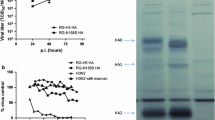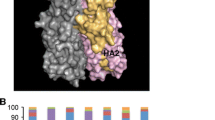Abstract
Avian influenza viruses preferentially use α2,3-linked sialic acid as a receptor for binding and entry into target cells. The sialic acid is the terminal residue of various types of glycan. There are two major types of α2,3-linked sialic acid differing in the penultimate bond: Neu5Acα2-3Galβ1-3GalNAc and Neu5Acα2-3Galβ1-4GlcNAc. In the human airway, while Neu5Acα2-3Galβ1-3GalNAc is present only in alveolar epithelial cells, the Neu5Acα2-3Galβ1-4GlcNAc is expressed in both the upper and lower airway. Previous data showed preferential binding of hemagglutinin from H5N1 highly pathogenic influenza virus to Neu5Acα2-3Galβ1-4GlcNAc. We further show here that suppression of this sialic acid by siRNA against a sialyltransferase, ST3GAL4, can inhibit H5N1 avian influenza virus infection and that this gene is abundantly expressed in human pharynx, trachea and bronchus. These data suggest that the ST3GAL4 gene is responsible for biosynthesis of the viral receptor and may play a crucial role in infection of H5N1 avian influenza virus in humans.



Similar content being viewed by others
References
Couceiro JN, Paulson JC, Baum LG (1993) Influenza virus strains selectively recognize sialyloligosaccharides on human respiratory epithelium; the role of the host cell in selection of hemagglutinin receptor specificity. Virus Res 29:155–165
Fouchier RA, Schneeberger PM, Rozendaal FW, Broekman JM, Kemink SA, Munster V, Kuiken T, Rimmelzwaan GF, Schutten M, Van Doornum GJ, Koch G, Bosman A, Koopmans M, Osterhaus AD (2004) Avian influenza A virus (H7N7) associated with human conjunctivitis and a fatal case of acute respiratory distress syndrome. Proc Natl Acad Sci USA 101:1356–1361
Gambaryan A, Yamnikova S, Lvov D, Tuzikov A, Chinarev A, Pazynina G, Webster R, Matrosovich M, Bovin N (2005) Receptor specificity of influenza viruses from birds and mammals: new data on involvement of the inner fragments of the carbohydrate chain. Virology 334:276–283
Gambaryan A, Tuzikov A, Pazynina G, Bovin N, Balish A, Klimov A (2006) Evolution of the receptor binding phenotype of influenza A (H5) viruses. Virology 344:432–438
Gambaryan AS, Tuzikov AB, Pazynina GV, Webster RG, Matrosovich MN, Bovin NV (2004) H5N1 chicken influenza viruses display a high binding affinity for Neu5Acalpha2-3Galbeta1-4(6-HSO3)GlcNAc-containing receptors. Virology 326:310–316
Gillespie W, Kelm S, Paulson JC (1992) Cloning and expression of the Gal beta 1, 3GalNAc alpha 2,3-sialyltransferase. J Biol Chem 267:21004–21010
Grahn A, Larson G (2001) Identification of nine alternatively spliced alpha2,3-sialyltransferase, ST3Gal IV, transcripts and analysis of their expression by RT-PCR and laser-induced fluorescent capillary electrophoresis (LIF-CE) in twenty-one human tissues. Glycoconj J 18:759–767
Ito T, Kawaoka Y (2000) Host-range barrier of influenza A viruses. Vet Microbiol 74:71–75
Kim YJ, Kim KS, Kim SH, Kim CH, Ko JH, Choe IS, Tsuji S, Lee YC (1996) Molecular cloning and expression of human Gal beta 1, 3GalNAc alpha 2,3-sialyltransferase (hST3Gal II). Biochem Biophys Res Commun 228:324–327
Kitagawa H, Paulson JC (1993) Cloning and expression of human Gal beta 1, 3(4)GlcNAc alpha 2,3-sialyltransferase. Biochem Biophys Res Commun 194:375–382
Kitagawa H, Paulson JC (1994) Cloning of a novel alpha 2,3-sialyltransferase that sialylates glycoprotein and glycolipid carbohydrate groups. J Biol Chem 269:1394–1401
Kitagawa H, Paulson JC (1994) Differential expression of five sialyltransferase genes in human tissues. J Biol Chem 269:17872–17878
Ku AS, Chan LT (1999) The first case of H5N1 avian influenza infection in a human with complications of adult respiratory distress syndrome and Reye’s syndrome. J Paediatr Child Health 35:207–209
Lee YC, Kojima N, Wada E, Kurosawa N, Nakaoka T, Hamamoto T, Tsuji S (1994) Cloning and expression of cDNA for a new type of Gal beta 1, 3GalNAc alpha 2,3-sialyltransferase. J Biol Chem 269:10028–10033
Matrosovich MN, Matrosovich TY, Gray T, Roberts NA, Klenk HD (2004) Human and avian influenza viruses target different cell types in cultures of human airway epithelium. Proc Natl Acad Sci USA 101:4620–4624
Nicholls JM, Bourne AJ, Chen H, Guan Y, Peiris JS (2007) Sialic acid receptor detection in the human respiratory tract: evidence for widespread distribution of potential binding sites for human and avian influenza viruses. Respir Res 8:73
Nicholls JM, Chan MC, Chan WY, Wong HK, Cheung CY, Kwong DL, Wong MP, Chui WH, Poon LL, Tsao SW, Guan Y, Peiris JS (2007) Tropism of avian influenza A (H5N1) in the upper and lower respiratory tract. Nat Med 13:147–149
Nicholls JM, Chan RW, Russell RJ, Air GM, Peiris JS (2008) Evolving complexities of influenza virus and its receptors. Trends Microbiol 16:149–157
Okajima T, Fukumoto S, Miyazaki H, Ishida H, Kiso M, Furukawa K, Urano T, Furukawa K (1999) Molecular cloning of a novel alpha2,3-sialyltransferase (ST3Gal VI) that sialylates type II lactosamine structures on glycoproteins and glycolipids. J Biol Chem 274:11479–11486
Peiris M, Yuen KY, Leung CW, Chan KH, Ip PL, Lai RW, Orr WK, Shortridge KF (1999) Human infection with influenza H9N2. Lancet 354:916–917
Shinya K, Ebina M, Yamada S, Ono M, Kasai N, Kawaoka Y (2006) Avian flu: influenza virus receptors in the human airway. Nature 440:435–436
Stevens J, Blixt O, Tumpey TM, Taubenberger JK, Paulson JC, Wilson IA (2006) Structure and receptor specificity of the hemagglutinin from an H5N1 influenza virus. Science 312:404–410
Suzuki Y, Ito T, Suzuki T, Holland RE Jr, Chambers TM, Kiso M, Ishida H, Kawaoka Y (2000) Sialic acid species as a determinant of the host range of influenza A viruses. J Virol 74:11825–11831
Suzuki Y (2005) Sialobiology of influenza: molecular mechanism of host range variation of influenza viruses. Biol Pharm Bull 28:399–408
Varki A, Cummings RD, Esko JD, Freeze HH, Stanley P, Bertozzi CR, Hart GW, Etzler ME (2008) Essentials of glycobiology, 2nd edn. Cold Spring Harbor Laboratory Press, New York
Wang PH, Lee WL, Juang CM, Yang YH, Lo WH, Lai CR, Hsieh SL, Yuan CC (2005) Altered mRNA expressions of sialyltransferases in ovarian cancers. Gynecol Oncol 99:631–639
Acknowledgments
Y.M. was supported by the Mahidol Medical Scholar Program. O.S. and C.B. were supported by the postdoctoral and research assistant program of the Faculty of Medicine Siriraj Hospital. The project was supported by a research grant from Thailand Research Fund.
Author information
Authors and Affiliations
Corresponding authors
Rights and permissions
About this article
Cite this article
Monteerarat, Y., Suptawiwat, O., Boonarkart, C. et al. Inhibition of H5N1 highly pathogenic influenza virus by suppressing a specific sialyltransferase. Arch Virol 155, 889–893 (2010). https://doi.org/10.1007/s00705-010-0658-4
Received:
Accepted:
Published:
Issue Date:
DOI: https://doi.org/10.1007/s00705-010-0658-4




